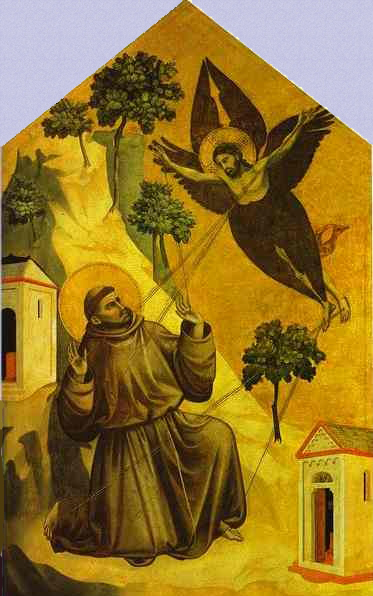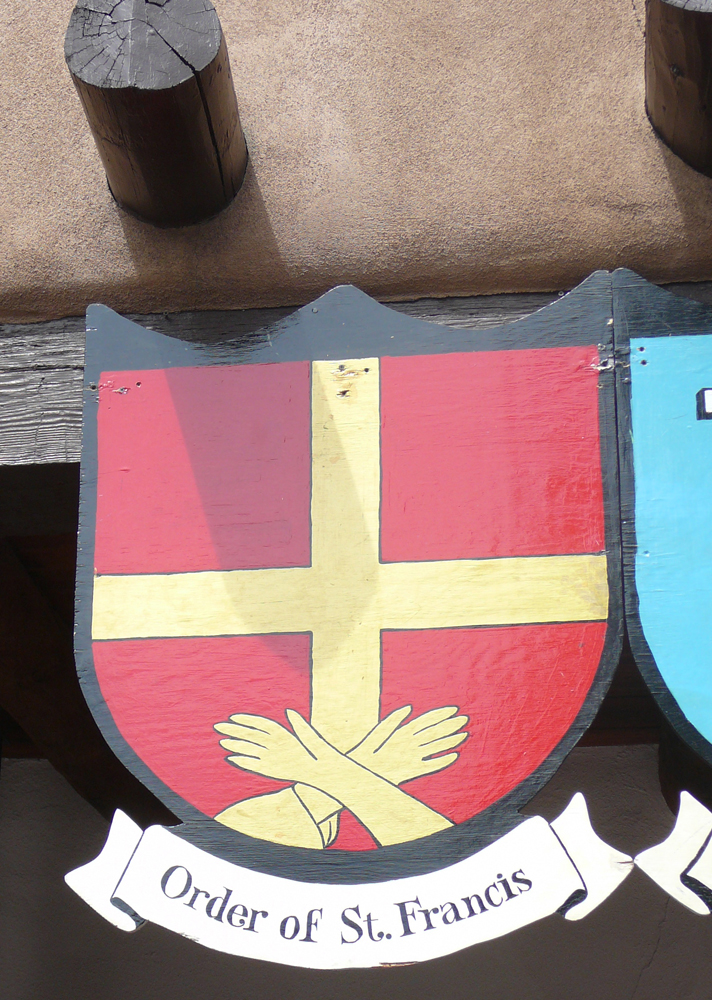stigmata,wounds in the hands, feet, and side that replicate those suffered by Christ on the cross. The second is the portrait tradition, in which the most important attributes are those five wounds. The third is the crossed-arms symbol, which also refers to Francis's ecstatic sharing of Christ's Passion.
THE stigmata
Most images of St. Francis receiving the stigmata stay close to the composition in the Giotto painting at right – and to the account in Thomas of Celano's biography: The saint had gone with a companion to Mount La Verna for forty days of prayer and fasting:One morning about the feast of the Exaltation of the Cross, while he was praying on the mountainside, Francis saw a Seraphim with six fiery wings coming down from the highest point in the heavens. The vision descended swiftly and came to rest in the air near him. Then he saw the image of a man crucified in the midst of the wings, with his hands and feet stretched out and nailed to a cross. Two of the wings were raised above his head and two were stretched out in flight, while the remaining two shielded his body.… As the vision disappeared, it left his heart ablaze with eagerness and impressed upon his body a miraculous likeness. There and then the marks of nails began to appear in his hands and feet, just as he had seen them in his vision of the Man nailed to the Cross.… His right side seemed as if it had been pierced with a lance and was marked with a livid scar.…1Like most paintings that followed it, the Giotto preserves just about everything in the narrative: the mountain, the six wings, the fire (here seen behind the lower wings), Christ's stretched-out hands and feet, and lines to show the impressing of Christ's wounds on Francis's body. An earlier passage tells of Francis taking the Gospel book from "an altar" while on the mountain, presupposing a church or chapel, so this and most other images also include one or two small chapels. Two elements omitted by Giotto that do appear in later works are the companion and the actual cross on which Christ's body is stretched. But these are often featured in other images (example).
In the Counter-Reformation of the 17th and later 16th centuries a number of paintings transform the stigmatization iconography into more emotionally engaging images that emphasize Francis as a contemplative, adapting the iconography of hermit saints. In Barocci's St. Francis the saint spreads his arms as in stigmatization images, but the setting is a cave and the saint stands before a gospel book contemplating a crucifix. Later, il Grechetto's St. Francis in Ecstasy abandons the stigmatization iconography entirely and puts the saint in a mountainous setting with a crucifix and skull.
PORTRAITS
The portrait tradition invariably includes the stigmata. Early portraits such as the Berlinghierri at right will show the marks in the hands and possibly the feet. In 1255 Pope Alexander IV declared that he had seen all five wounds himself; after that, portraits usually represented the wound in the side by means of a rip in the saint's habit (example).2 Even images of his receiving the stigmata may show the rip (example).St. Francis is almost always pictured with a short beard or none at all. There will be three knots in the cord that serves as a belt in his Franciscan habit, although in some early examples that practice had not yet been adopted. The Berlinghierri at right has four knots; another by Giunta Pisano from 1253 has seven (photograph in Robson, 21).
THE CROSSED-ARMS SYMBOL
Thomas of Celano says of the stigmata that Francisrealized by divine inspiration that God had shown him this vision in his providence, in order to let him see that, as Christ's lover, he would resemble Christ crucified perfectly not by physical martyrdom, but by the fervor of his spirit.For this reason the Cross and the Crucifixion are frequent themes in the iconography of St. Francis. One expression of this relationship is the shield that the Franciscan order has been using since the 15th century, where Christ's bare arm crosses over Francis's sleeved arm, with the Cross as a background (as at right). Often the hands have nail marks, as in this example.3
FRANCIS AND THE PASSION OF CHRIST
The symbol is not the only image memorializing Francis's entry into the Passion. In one striking painting of the Crucifixion "Christ's lover" hugs the foot of the Cross in grief, exactly the attitude in which Mary Magdalene is often painted. In a possible reference to the feast of the Exaltation of the Cross, the day when he received the stigmata, another painting has him stand beside the True Cross with St. Helena. In a portable altar of the 15th century, he and St. James flank images of the Man of Sorrows and the Virgin and Child. Additionally, in about half of the portraits and statues I have examined he holds a small cross in his right hand (example).NARRATIVE IMAGES
A number of works present the whole sequence of events in Francis's life (example), notably in the Basilica of San Francesco in Assisi. Sometimes a narrative sequence will accompany a portrait, as in the Berlinghierri above right or the predella beneath the Giotto.
Prepared in 2013 by Richard Stracke, Emeritus Professor of English, Augusta University.
HOME PAGE

Giotto, 1295 (See the description page)

Berlinghierri, 1235 (See the description page)

Shield from a Parish Guild, New Mexico, 2009 (See the description page)
ATTRIBUTES
- Wounds in hands, feet, and side
- Brown habit with cord belt, usually with three knots in the belt
- Hand cross
MORE NARRATIVE IMAGES
- 1260-70: Altarpiece with four of St. Francis's miracles.
- 13th century: Enamel: St. Francis receives the stigmata.
- Early 14th century: St. Francis's portrait is among Aretino's panels of Apostles and saints in Santa Maria Novella, Florence.
- 14th century: A painting of Francis's encounter with the Sultan of Egypt, one of a set of 26 narrative panels by Taddeo Gaddi.
- 1320-25: The left leaf of Jacopo del Casentino's Madonna and Child Enthroned triptych pictures St. Francis receiving the stigmata.
- 1325-50: Pseudo-Jacopino, The Death of St. Francis.
- 1477: Francis and St. Anthony of Padua are pictured as rather severe ascetics in Friedrich Pacher's portrait.
- 1515-20: Calzolaretto, The Stigmata of St. Francis and Saints.
- 1536: One of Bassano's Madonna paintings includes St. Francis and a namesake, the donor's brother, Francesco Soranzo.
- 18th century: Painting of St. Francis's pilgrimage to Compostela.
MORE PORTRAITS
- 2nd half of the 13th century: A diminutive figure of St. Francis is placed between St. Peter and the Virgin Mary on the left side of the apse mosaic at St. John Lateran in Rome, next to an even smaller figure of Pope Alexander IV (reigned 1254-61). The two figures are said to have been included by order of that pope, but my sources date the mosaic as 1287-92.4
- 14th century: On one wing of a portable altar.
- 1449: Detail in a Vivarini polyptych.
- 1450: The Ugljan Polyptych.
- 1506: Detail from a Crucifixion painting.
- 1516: With other saints and the Madonna in a painting in Assisi.
- 1581: Joining St. Catherine and the Doge in prayer for Venice.
- 16th or 17th century: Santo in Oaxaca, Mexico.
- 18th century: Statue in Caceres, Spain.
- 1753: In the margin of a Mexican nun's badge.
- 1749: Velázquez's Sacra Conversazione.
- Second half of the 18th century: Another Mexican nun's badge with St. Francis.
- 1770-80: In this painting of Christ carrying the cross, Francis helps rescue the souls in Purgatory.
- 18th/19th century: Statue in a California mission.
- 18th century: The Franciscan shield on the façade of an 18th-century mission in Arizona
DATES
- Feast day: October 4
- Lived 1182-1226
BIOGRAPHY
- Thomas of Celano's official 1230 biography (Stouck has excerpts).
- Ugolino of Montegiorgio, Little Flowers of St. Francis.
-
Golden Legend # 149: html or pdf.
- Early South English Legendary, 53-67.
- Carolus de Smedt et al., "La Légende de S. François d'Assise dite «Legenda trium sociorum»," Analecta Bollandiana, XIX(1900), 119-197.
- The Roman Breviary: English translation, IV, 622-24; Latin original, 1060-62.
ALSO SEE
NOTES
1 Stouck, 498-500.
2 Robson, 23.
3 Stouck, 500. "Common Symbols."
4 Robson, 23.